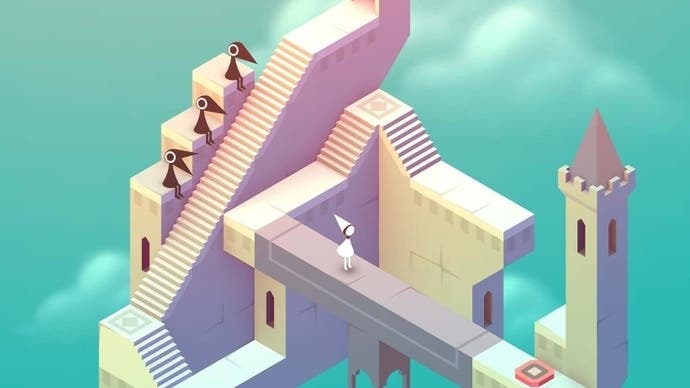To play Monument Valley is to marvel at how it works
Ups and downs.
What is the world made of? In games and films the answer is often surprising. There is a wonderful moment in Inception in which Ariadne - Jesus, Nolan - takes a Parisian boulevard and folds it over on itself. It's one of those instances of sheer cinematic glory: the horizon rises up and bends back, until buildings rest overhead and the sky is dark with tarmac and cobbles.
Beyond the effects, what sells this moment? The reactions, certainly: DiCaprio as ever gets a lot into the business of doing very little. But there's also a sound effect that for me elevates the whole thing. What should it sound like for a city to fold over on itself? In Inception it sounds both sparse and industrial: the core of the thing is the sound of an iron support pinging and creaking under growing strain. Paris is made of limestone, isn't it? But in Inception, for this instance, it's really made of iron: the framework bends and flexes but will ultimately hold. Paris, like Irn Bru, is made of girders.
Inception is a movie with architectural preoccupations, so perhaps this flair for buried structure should be expected. Monument Valley, which I've been playing on and off for the last few weeks, also has architectural preoccupations. So what is this world made of? Taut strings plucked and clockwork turning: you move the landscape around and you hear evidence of escapements and other watch parts, dainty old music boxes and tightly rigged automata. All of this conjured through sound. All of this the kind of stuff that children ought not be allowed to play with for fear of damaging.
Deeply childish, for years I avoided playing the Monument Valley games, even though they seemed to exist at the intersection of so many things I find fascinating: art, architecture and optical illusions. Over the last month or so I have finally entered their delicate world. I've done 'em all: the first game, various bits of what seem to be DLC, and finally, this last week, the sequel, Monument Valley 2. It's been very interesting. These are beautifully made games, and they seem to me to raise a number of questions about craft in games, about the relationship between the player and the designer, and about the roles, as it were, that the player and the designer often inhabit in unstated ways.
Playing them in such a compacted time period has been very rewarding. Over the course of the games I can see that they have changed quite a lot. There is a sense throughout of an idea evolving, of new minds coming in and seeing new potential. As the elements get more complex, there's also that thing you get with Lego sets, with new bricks being invented to suit specific needs, and then entering the wider pool of available Lego bricks in general, where they in turn become part of the standard arsenal of future designers. Levels get more complicated and also more streamlined: designers learn how to be audacious, but also how to get out of their own way.
Even so, at the heart of it all, some things never change. Monument Valley levels are puzzles, in which you must get from the starting point to a distant finishing line, often traversing different screens. The landscape on these screens is one of Escher-style architecture, middle-eastern and north-African-influenced buildings in which optical illusions allow strange things to exist. Circular stairs that go upwards forever in a maddeningly finite loop, occlusions that may or may not create barriers, moments in which a wall becomes a ceiling or a floor becomes a wall. Escher has never been entirely respectable, I suspect, but I think his stuff is potent and transporting. This is the kind of art - part decoration, part brain-teaser - that is beloved of the people who choose the covers for maths textbooks. It is the kind of art that dentists often frame on the ceiling above the chair, so the mind has a space to roam while people are getting root canals. It is the kind of art that plucks at you as you move your focus over it, the kind of art where the parts stand out while the whole is only infrequently available to be grasped.
Across these landscapes, I would say that there are two basic elements to the classic Monument Valley puzzle. One of them is rooted in optical illusions and the other is rooted in mechanics and the physical transformation of the landscape.
In terms of the optical illusions, Monument Valley allows for simple delight: if you can find a perspective in which two distant points look like they are joined, you can walk across as if they are joined. Perspective dictates reality, and so you play the game by turning each level's diorama around and around and looking for visual quirks that you can exploit, paths and staircases you can essentially trick into being.
This is exceedingly clever. Other games have done it over the years, sure, but it still looks and feels like genuine magic every time. It's something about our confusion over the separation and interaction of 2D and 3D worlds, their oil-and-water qualities. It's something about the eye's ability to not just see a landscape but to mis-see it in creative ways, to get to work cognitively on things that have been misperceived, and to make them convincing and even practical.

The other kind of puzzle element is also exceedingly clever. Sometimes you will be able to raise or lower a piece of the environment or twist a dial and set an individual tower or courtyard spinning. Sometimes a switch will lead the castle you are moving around to transform, new staircases concertinaing up out of the ground, new doorways turning into view.
Transformation! These mechanical sorts of puzzles grow massively in ambition throughout the course of the games. They gain a sense of pace and a sense almost of storytelling in and of themselves. They develop individual beats and punchlines. There is one level where you lift an entire castle up to reveal a variety of little worlds within it. There is another where the water level in a sequence of rooms moves about as you require it.
These kinds of puzzles strike me as being particularly emblematic of Monument Valley, because, as a player, I find them hard to predict in any way. I often can't solve them in my head, because I have no idea what the art team is going to do to contort the landscape around me when I press a switch, so I can't imagine myself in any meaningful way into the heart of a problem. Instead, I have to become a bit of a plodder, working my way from one switch to the next, the puzzle role I'm ultimately given amounting to navigation, while the designers get to fold, crumble, reconfigure.
This sounds like a criticism, but I think it actually gets to the heart of what is going on with Monument Valley. It gets to the heart of the relationship between player and designer. These puzzles are ultimately satisfying to solve, I think, because while you're largely just navigating and hitting switches, you're constantly encouraged to think about the effort and the ingenuity, the magical papercraft engineering smarts, that went into everything around you. Monument Valley looks like spatial logic, but it is primarily spectacular - its main appeal is as a genuine spectacle that you get to move through and try to understand.
To play Monument Valley is to marvel at how it works, what it does as you move through it, how one level can be a single screen - a cave or rampart - and another can be a series of nested mazes. In truth, I'm convinced that the people who were truly playing Monument Valley in the traditional sense were the people designing it, working out how to get new effects and new gimmicks out of the basic conceit. The rest of us are sort of museum goers as much as players - actors as much as people with real agency. Hit our marks, do our tinkering, weight our switches, but ultimately we're there to enjoy the - very real, very vivid - pleasures of witnessing great skill on behalf of the people who put it all together for us.
As transactions go, this feels entirely fair. Many aspects of art are there to dazzle, to engage through beauty and the display of obvious effort and skill. From a distance, I always thought the Monument Valley games were self-satisfied, but I see now that I was lacking in generosity. What they do seem to be is self-contained, while not entirely airless. They have that sense that a lot of single-solution puzzle games have of being so thoroughly completed by the designers, far before the player arrives, that you are always very clearly following in people's footsteps.
As for why I feel this more clearly - this sense of being the second player, arriving long after the designer has passed by - with Monument Valley than with dozens of other similarly stylish, similarly self-contained puzzle games, I don't fully know. I wonder if it's down to a question of bearing. Tonally, Monument Valley struggles with the quiet tyranny of extreme good taste, unable to create a dynamic range of moods or emotions for its stories when everything is so poised and so elegant. What is this world made of? It is made of cleverness.



